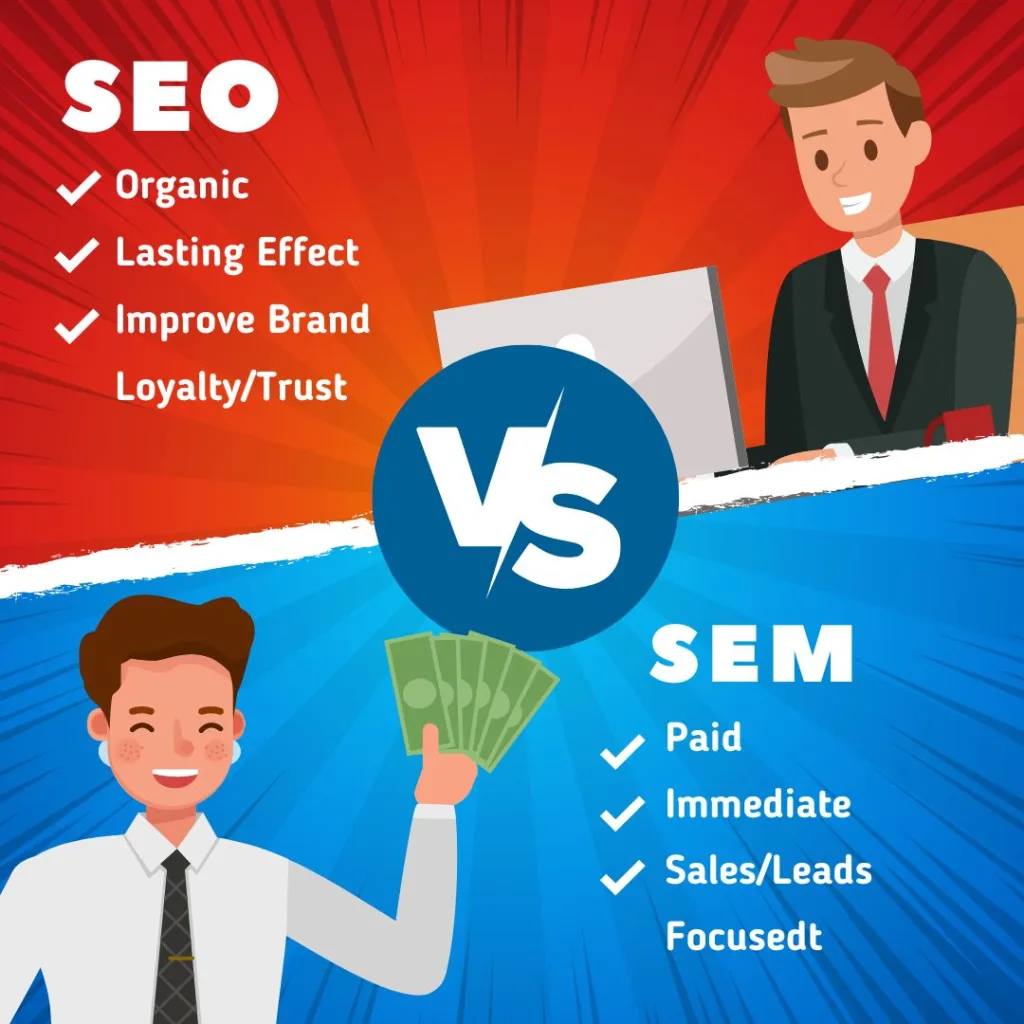In today’s digital landscape, marketers are using SEO and SEM to enhance content visibility on search engines. By strategically optimizing websites and running targeted ad campaigns, businesses can drive organic traffic and reach their target audience effectively.
Business can stay ahead in the competitive online space with these powerful strategies.
SEO and SEM – are the two main concepts of digital marketing. These two terms are just two sides of the same coin as their goals are the same–to attract more customers, but their actions and aspects are way apart from each other.
Let’s understand this with an example —
Suppose you own a small jewelry business, so what will you do to make your website visible on SERP at rank 1? You will optimize your website through SEO to improve search engine rankings, and if you want immediate results, then you will go for SEM.
But the combination of these two terms is occasionally used to describe a comparable range of activities, which can lead to confusion for those of us who are less familiar with this field.
So, what is something that differentiate search engine marketing(SEM) and search engine optimization(SEO) with each other? How do they relate and work together?
Read this article and get ready to embark on a thrilling journey through the realms of digital marketing, where SEO and SEM unite to ignite your online presence.
What is SEO and how does it work?
Those who are in the digital marketing field, they know that SEO is the key element in the same. So before going ahead, let’s get knowledge through some data that is essential for those also who don’t even belong to this field.
According to NetMarketShare, Google dominates the global search traffic with over 79%. Other search engines like Bing, Baidu, and Yahoo have significantly lower market shares of 7% or less. Although Google is the primary focus for SEO, we should keep in mind that these other search engines still exist, but their influence is minimal.
Now what is SEO –
Imagine planning a vacation and wanting to find the best hotel in a particular city. You open a search engine like Google and type in “best hotels in [city name].”
Within seconds, you’re presented with a list of results.
Have you ever questioned how search engines decide which hotels to show first? That’s where SEO comes in.
Search Engine Optimization, or SEO, is like a popularity contest for websites. Search engine crawlers analyze different website factors, such as keywords, tags, and links, to determine how well they can attract visitors. Websites optimized for SEO have a higher chance of appearing at the top of search results, making it easier for people to find them.
Now what search engine Crawlers usually look for —
- Quality Content – “Hey, want to build a brand? Create content that makes you stand” Having high-quality content sends a message to search engines that your website and business offer valuable goods or services. Search engines evaluate this through factors like link building and keywords.
- User Experience– Does your website provide a seamless experience for users? Is it fast, user-friendly, and easy to navigate? Can users accomplish their goals effortlessly, such as making a purchase?
- Linking patterns: “Hey, is your website sinking? Then start backlinking” Linking patterns refer to the strategic arrangement of hyperlinks within a piece of content. These patterns help guide readers through related information, enhance user experience, and improve website navigation.
Learning the basics of SEO can benefit digital sales and marketing efforts. However, mastering it requires time and technical expertise. Consider hiring a Digital Marketing agency where an SEO expert is there to help you maximize website conversions and attract more traffic. And for that, look no further than YelloMonkey Labs.
What is SEM and how does it work?
Search Engine Marketing (SEM) involves paid search advertising, such as Google Ads. Think of it as renting prime advertising space at the top of search results.
Let’s take an example – when searching for “best smartphones,” the ads you see above the organic results are SEM. Advertisers strategically choose keywords and create compelling ads to capture the attention of potential customers, requiring expertise and strategy to maximize their impact and drive desired results.
Examples of SEM-based advertising activities include:
- Running targeted paid ad campaigns
- Crafting copy with specific keywords
- Managing advertising budgets
- Analyzing performance indicators like CTR and CPC to guide future campaigns.
See, what’s the whole concept of SEM is –
“When it’s done poorly, it will be no use, but when it’s done well, it will definitely make your product sell”
SEO v/s SEM
When discussing the differences between SEO and SEM, we are essentially referring to distinct approaches to advertising.
SEO is like a bookshelf- Just like a well-organized bookshelf helps us find and access our favorite books easily, SEO optimize a website’s content and structure to make it more discoverable by search engines and users, ensuring that the desired information is readily accessible.
On the other hand, SEO is like a billboard. Similar to how a billboard grabs attention and promotes a specific message to a targeted audience, SEM utilizes paid advertising to display targeted ads prominently in search engine results.
Last thought:
So, the conclusion is that a comprehensive digital marketing strategy often incorporates elements of both SEO and SEM to maximize reach, visibility, and conversions. If you’re looking for agency support in the areas of SEO, SEM content marketing and paid media, get in touch with YelloMonkey Labs.

